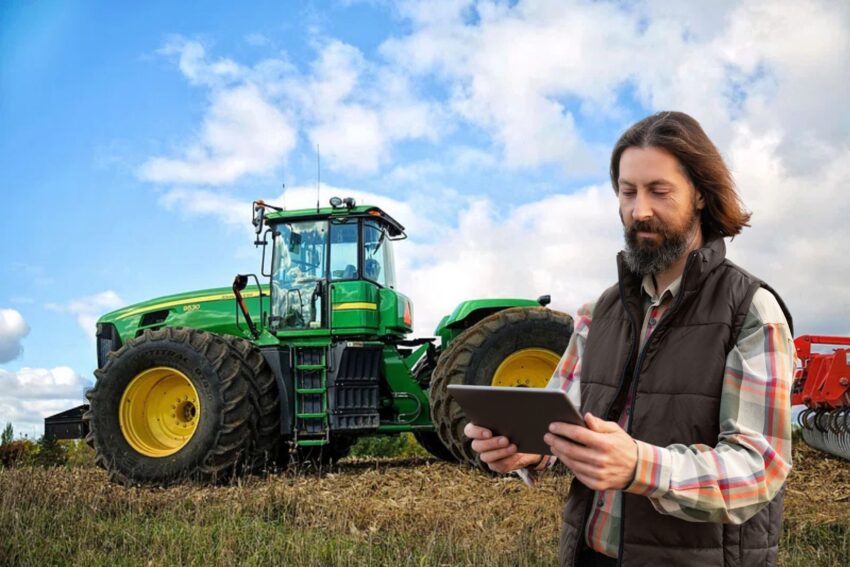In an era where technology intersects with traditional industries, John Deere, a titan in agricultural machinery, has unveiled a new line of autonomous tractors, signaling a significant shift towards smarter farming. This announcement, made at CES 2025, comes at a critical time when the American agricultural sector grapples with a severe labor shortage, traditionally addressed through the H-2A visa program for temporary agricultural workers, and more recently, a reliance on employing illegal immigrants under the table.
The New Autonomous Fleet
John Deere’s latest offerings include not only tractors but also extend to autonomous orchard sprayers, mining trucks, and commercial mowers, all designed to make farming more efficient and less dependent on human labor. The second-generation autonomy kit, featuring advanced computer vision and AI, allows these machines to navigate complex environments with a 360-degree view, thanks to 16 individual cameras. This technology aims to tackle one of the most labor-intensive periods in farming, tillage, by allowing machines to operate around the clock without human intervention.
John Deere unveils autonomous tractors, orchard sprayers, mining trucks, and mowers at CES, addressing labor shortages with advanced technology and improved obstacle avoidance systems.#engineering #InterestingEngineering #CES #CES2025 #AutonomousTractors #smartfarming pic.twitter.com/kHMRtWzORN
— Interesting Engineering (@IntEngineering) January 7, 2025
Addressing Labor Shortages
The agricultural sector in the United States has long relied on foreign labor to fill the gap left by a declining domestic workforce. The H-2A visa program has seen a dramatic increase in usage, with certified positions reaching over 370,000 in fiscal year 2023, highlighting the dependency on seasonal labor from abroad. However, this system has its limitations, particularly in supporting year-round operations like dairy or livestock farming, which require continuous labor.
The labor shortage has been exacerbated by various factors, including an aging domestic workforce, tightening of border policies, and competition from other industries. The American Farm Bureau Federation estimates an annual need for roughly 2.4 million farm jobs, a demand that seems increasingly challenging to meet with traditional labor sources.
Autonomy as an Alternative
John Deere’s push towards autonomous machinery is seen as a direct response to these labor challenges. With the capability to work autonomously, these tractors can perform tasks like plowing, planting, and harvesting without the need for a human operator, thereby potentially reducing the reliance on temporary labor. This innovation not only addresses the labor shortage but also aims to enhance productivity, optimize resource use, and reduce the physical strain on farmers, allowing them to focus on other critical aspects of their operations.
Moreover, the adoption of autonomous technology could lead to a shift in job roles, moving from traditional field labor to positions that require skills in managing and maintaining high-tech equipment. This transition could open new job pathways for younger generations, perhaps those more familiar with technology than with traditional farming practices.
Challenges and Considerations
However, the move towards autonomous farming isn’t without its hurdles. The initial investment in such technology is significant, with costs potentially adding tens of thousands to the price of traditional equipment. There’s also the question of how this technology will be integrated into existing farming practices, particularly among small to medium-sized farms, which might not have the capital to invest in such systems.
Additionally, there’s the debate over the impact on the workforce. While autonomous tractors might lessen the need for traditional farm labor, they could also displace workers unless there’s a corresponding shift towards tech-related jobs in agriculture. There’s also the concern about the control of farming operations moving away from farmers to tech companies, raising issues of data privacy and autonomy in agricultural decision-making.
Conclusion
John Deere’s introduction of a fleet of autonomous machines at a time when the U.S. is reevaluating its immigration policies for agricultural labor marks a pivotal moment. It suggests a future where technology might replace or supplement human labor in significant ways, potentially reshaping how we think about farming, labor, and technology’s role in agriculture. As with any technological shift, the benefits must be weighed against the potential societal and economic impacts, ensuring that while we advance in efficiency, we also consider the human element of farming.


